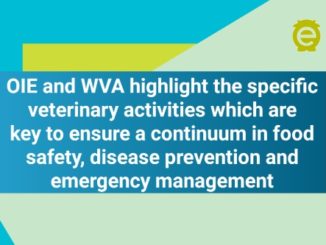SARS-CoV-2, the virus that causes COVID-19 in humans, we are still learning about this novel zoonotic virus, and it appears that in some rare situations, human to animal transmission can occur.
The United States Department of Agriculture (USDA) recently reported a confirmed infection of SARS-CoV-2 in a tiger with a respiratory illness in New York, which is the first confirmed case of SARS-CoV-2 infection in animals. Several other big cats (tigers and lions) in a neighboring enclosure at the zoo also developed a mild respiratory illness, but all are expected to recover. Clinical signs thought to be compatible with SARS-CoV-2 infection in animals include fever, coughing, difficulty breathing or shortness of breath, lethargy, sneezing, nasal discharge, vomiting, and diarrhea.
For veterinary clinic staffs
- Everyone who enters the clinic, including employees and visitors, wear a cloth face covering over their nose and mouth.
- Only emergency cases should be attended during this time. Veterinarians should use professional judgement when determining whether a case is urgent or non-urgent.
- Before scheduled appointments or upon arrival, veterinary doctor should ask if the pet has had any exposure to a person with suspected or confirmed COVID-19.The clinic should use all appropriate precautions to minimize contact with the person bringing the animal to the clinic.
- Direct the pet owner and patient to be in a single exam room or isolation room. Clean and disinfect the room, surfaces, supplies, door, or equipments located within 6 feet of pet owners after they leave.
- Veterinarians should wear proper PPE (Personal Protective Equipment) for attending cases where someone is sick with COVID-19. Clinical signs in animals: The clinical spectrum of illness for the SARS-CoV-2 virus remains largely undefined in animals. Clinical signs expected to be compatible with possible SARS-CoV-2 infection in mammalian animals may include: Fever, Coughing Difficulty breathing or shortness of breath Lethargy Sneezing Nasal/Ocular discharge , Vomiting and Diarrhea
- Veterinarians and their staffs should review the concepts in the NASPHV Compendium of Veterinary Standard Precautions for Zoonotic Disease Prevention in Veterinary Personnel. These guidelines are applicable regardless of ongoing infectious disease outbreaks but are especially important during an outbreak of an emerging infectious disease such as COVID-19.
- Reusable (i.e. washable) gowns are typically made of polyester or polyester-cotton fabrics. Gowns of these fabrics can be safely laundered according to routine procedures and reused. Respiratory protection that is at least disposable N95 filtering facepiece respirator is recommended.
- Veterinarians are strongly encouraged to rule out other, more common causes of illness before considering SARS-CoV-2 testing, especially among animals without a COVID-19 exposure. Take a thorough history to assess for likely exposure or risk factors in the 2 weeks prior to symptom onset, such as whether the animal has been in contact with a person diagnosed with COVID-19, a person with COVID-19 compatible symptoms.
- Veterinarians should recommend home isolation in suspected cases of animals. Advise the pet owner to do the following: Have the pet stay in a designated “sick room” (such as a laundry room or extra bathroom) if possible, or otherwise be separated from people and other animals. Limit interaction with the isolated pet as much as possible. If possible, the pet should use a litterbox or bathroom that is separate from other animals.
What to do if an animal tests positive for SARS-CoV-2
If an animal test is presumptive positive, veterinarians should immediately contact their state public health veterinarian or state veterinarian regarding next steps, and the testing laboratory should contact USDA’s National Veterinary Services Laboratories for guidance on forwarding samples for conrmatory testing. Conrmed SARS-CoV-2 infections in animals must be reported by USDA to the World Organisation for Animal Health (OIE).
We are still learning about this virus, and it appears that in some rare situations, people can spread the virus to animals. Further studies are needed to understand if and how different animals could be affected by the virus and the role animals may play in the spread of COVID19.
Dogs in households with access to private areas should be limited.Interaction with other people or animals should be avoided. Cats should be kept inside in a designated area away from people and other animals. Do not allow cats positive for SARS-CoV-2 to roam outside.
At this time, there is no evidence that animals play a significant role in spreading the virus that causes COVID-19, but there are other zoonotic diseases that can spread between animal and people, so it is always a good idea to practice healthy habits around pets and other animals, including washing hands before and after interacting with them. Provide bedding, bowls or containers, treats, and toys that are separate from those used by other people or animals in the household. Disinfect bowls, toys, and other animal care items with an EPA-registered disinfectant and rinse thoroughly with clean water afterwards. Soft items like towels, blankets, and other bedding, can be safely laundered and reused.
Avoid taking the pet to human healthcare facilities, schools, dog parks, parks, groomers, and pet daycares, pet stores, boarding facilities, or similar places until the animal is cleared.
IMPORTANT
What to advice pet owners during the COVID-19 outbreak
At this time, there is no evidence that animals play a significant role in spreading the virus that causes COVID-19. Based on the limited data available, the risk of animals spreading COVID-19 to people is considered to be low. Further studies are needed to understand if and how different animals could be affected by the virus and the role animals may play in the spread of COVID-19. We are still learning about this virus.
- Ask the pet owner to avoid contact with their pet, including petting, snuggling, being kissed or licked, and sharing food or bedding.
- Ask them to wash hands before and after interacting with them and wear a cloth face covering.
- Although we know certain bacteria and fungi can be carried on fur and hair, there is no evidence that viruses, including the virus that causes COVID-19, can spread to people from the skin, fur, or hair of pets.
- Do not let pets interact with people or other animals outside the household. Walk dogs on a leash, maintaining at least 6 feet from other people and animals. Avoid dog parks or public places where large numbers of people and dogs gather.
- Keep cats indoors when possible to prevent them from interacting with other people or animals. Because all animals can carry germs that can make people sick, it’s always a good idea to practice healthy habits around pets and other animals.
- Ask the owners to wash their hands after handling animals, their food, waste, or supplies. Practice good pet hygiene and clean up after pets properly.
- Visit CDC’s Healthy Pets, Healthy People website for more information on keeping animals and people safe and healthy. At this time, routine testing of animals for this new coronavirus is not recommended.
Reference: Advisory of Center for Disease Control and prevention Click to see
|
The content of the articles are accurate and true to the best of the author’s knowledge. It is not meant to substitute for diagnosis, prognosis, treatment, prescription, or formal and individualized advice from a veterinary medical professional. Animals exhibiting signs and symptoms of distress should be seen by a veterinarian immediately. |






Be the first to comment